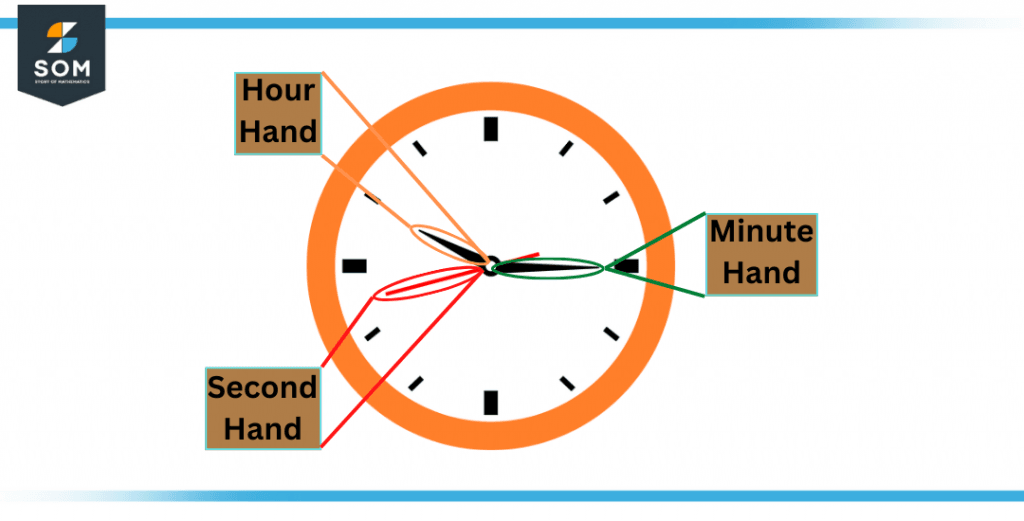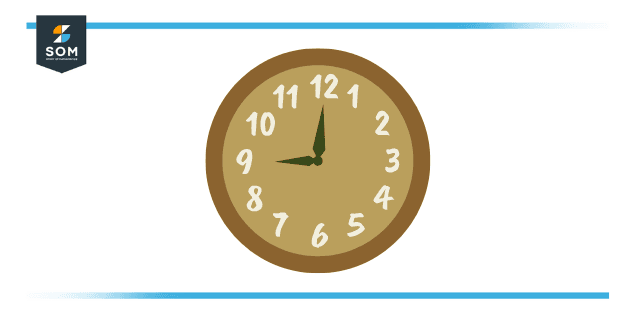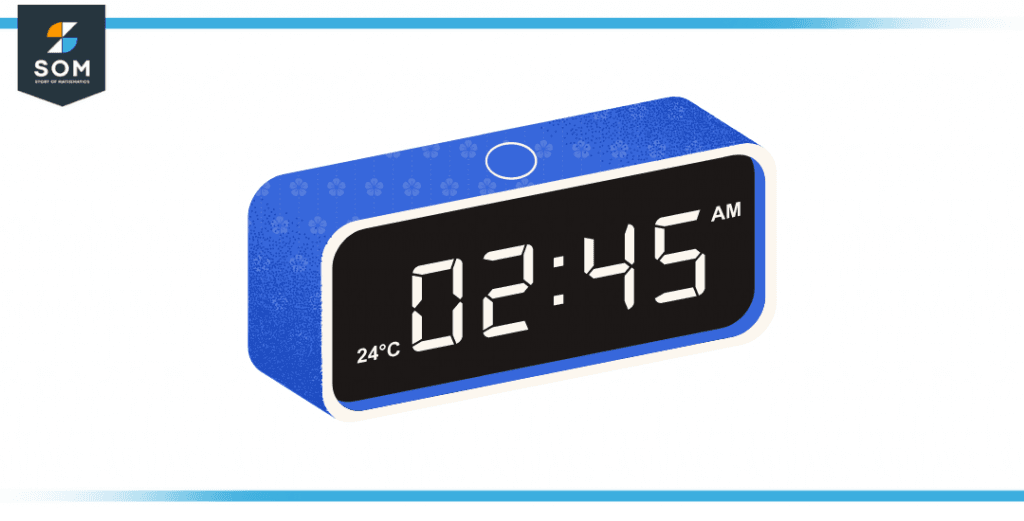JUMP TO TOPIC
Hour Hand|Definition & Meaning
Definition
In an analog clock, the smallest of the three hands that refers to the hours is called an hour hand. The hour hand makes one complete revolution of the clock in 12 hours.
What Is an Hour Hand?
The hour hand, also known as the shorthand, is a pointer on a clock or watch that indicates the hour of the day. It is typically shorter than the minute hand, which is used to indicate the minutes. The hour-hand rotates around the clock face, completing one full rotation every 12 hours or half a rotation every 6 hours.
The hour hand is an essential component of a clock or watch, as it allows the user to tell the time quickly and accurately. This is because the hour hand points to the hour markers on the clock face, which are usually large and marked. The hour markers on a clock face can be Roman numerals, Arabic numerals, or even simple dots or lines.
It is typically driven by a gear train, which is powered by the clock‘s or watch’s main spring or battery. The gear train is a series of gears that transmit power from the main spring or battery to the hour hand, causing it to rotate at a steady and precise rate.
The hour hand is also attached to the center of the clock or watch by a pivot, which allows it to rotate smoothly and freely around the clock face.

Figure 1 – Different Hands of an Analog Clock
What Is an Analog Clock?
An analog clock is a traditional clock that uses hands to indicate the time. It is also called a “mechanical clock” or “traditional clock” because it uses mechanical parts such as gears, springs, and a pendulum to keep time. The clock face is usually round and divided into numbers, usually 12, that indicate the hours of the day.
The clock face usually has two hands, the shorter one (the hour hand) that indicates the hour and the longer one (the minute hand) that indicates the minutes. Some analog clocks may also have a third hand (the second hand) that indicates the seconds.
Analog clocks are widely used in many different settings, such as homes, offices, schools, and public spaces. They are often used as wall clocks, table clocks, and even wristwatches. They are considered to be more traditional and classic in design, and many people find them to be more aesthetically pleasing than digital clocks.

Figure 2 – An Analog Clock
How Are Analog Clocks Useful in Mathematics?
Analog clocks can be useful in mathematics in several ways:
Teaching Time
An analog clock can be used to teach students how to tell time, read the clock face, and understand the concepts of hours, minutes, and seconds.
Solving Word Problems
They are used to help students visualize and solve word problems that involve time. For example, if a train leaves at 3:00 PM and arrives at 5:00 PM, how long was the train ride?
Understanding Angles
Such clocks can be used to teach students about angles and how the hour and minute hands on a clock form different angles as time passes.
Measurement
They are used to teach students about measurement by having them measure the time it takes for an event to occur and compare it to the time on an analog clock.
Elapsed Time
Analog clocks can be used to teach students about elapsed time, which is the amount of time that has passed between two events. For example, if a student starts a math test at 1:00 PM and finishes at 2:00 PM, the elapsed time is one hour.
Calculating Speed
To teach students how to calculate speed by measuring the time it takes for an object to travel a certain distance and dividing it by the distance traveled.
Geometry
To teach geometric concepts such as circles, radii, and central angles.
What Is a Digital Clock?
A digital clock is a type of clock that displays the time using digits (numbers) rather than hands on a clock face. The time is typically displayed on an LED, LCD, or another type of digital display.
They can be found in a wide variety of settings, including homes, offices, schools, and public spaces. They can be in the form of wall clocks, alarm clocks, stopwatches, and even wristwatches.
Digital clocks are known for their accuracy and ease of use. They often have the ability to set alarms, display the date, and have other features such as a stopwatch, countdown timer, and temperature display. They are also easy to read, especially for people with vision impairments or for those in dimly lit areas.
These clocks are powered by batteries or an AC adapter, and they use a quartz crystal oscillator to keep time, which is a device that generates a precise electrical signal that drives the clock. This allows for a high degree of accuracy and precision in timekeeping.

Figure 3 – A Digital Clock
What Defines an Hour on a Clock?
An hour on a clock is defined as a period of time that is equal to 1/24th of a day. The standard definition of an hour is based on the time it takes for the Earth to complete one rotation on its axis, which is approximately 24 hours.
An hour is separated into 60 equal parts, called minutes, and each minute is further divided into 60 equal parts, called seconds. Therefore, one hour is equal to 60 minutes or 3600 seconds.
Analog clocks and watches use a system of gears and a pendulum to divide the hour into smaller units of time, such as minutes and seconds. The minute hand points to the minute markers, which are usually smaller and less prominent, and the second hand, if present, points to the second markers, which are usually even smaller and less prominent.
Useful Facts About the Hour Hand
The hour hand, also known as the shorthand, is a pointer on a clock that indicates the hour of the day.
It is shorter than the minute hand, which is used to indicate the minutes.
It rotates around the clock face, completing one full rotation every 12 hours or half a rotation every 6 hours.
It is an essential component of a clock, as it allows the user to tell the time quickly and accurately.
It is typically driven by a gear train, which is powered by the clock‘s main spring or battery.
The hour hand is also attached to the center of the clock by a pivot, which allows it to rotate smoothly and freely around the clock face.
In a traditional clock, the hour hand is usually linked to the minute hand by gears, which means that when the minute hand moves, the hour hand moves too.
Solved Examples Related to Hour Hand of a Clock
Example 1
a) If the hour hand on a clock is pointing at 12, what time is it?
b) If the hour hand on a clock is pointing at the 3, and the minute hand is pointing at the 12, what time is it?
c) If the hour hand on a clock is pointing at 6, and the minute hand is pointing at 45, what time is it?
Solution
a) The hour hand on a clock is pointing at 12, which means it is 12:00 or 12 o’clock.
b) The hour hand on a clock is pointing at 3, which means it is 3 o’clock. The minute hand is pointing at the 12, which means it is 12 minutes past the hour. Therefore, the time is 3:12.
c) The hour hand on a clock is pointing at 6, which means it is 6 o’clock. The minute hand is pointing at 45, which means it is 45 minutes past the hour. Therefore, the time is 6:45.
Example 2
If the hour hand on a clock is pointing at 9, and the minute hand is pointing at 30, what time will it be in 45 minutes?
Solution
The hour hand on a clock is pointing at 9, which means it is 9 o’clock. The minute hand is pointing at the 30, which means it is 30 minutes past the hour. If we add 45 minutes to the current time, the hour hand will move to point at 10, and the minute hand will point at 15.
All the images are created using GeoGebra.
